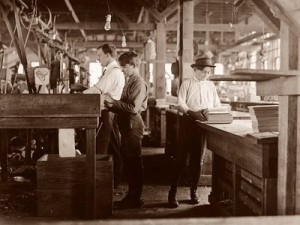Illegal Immigration is largely like the weather. To quote Mark Twain, “Everybody talks about the weather, but nobody does anything about it.” Of course that isn’t entirely true with regard to immigration as different states and even local municipalities have attempted to put into law statues that would in various ways limit the rights if undocumented workers. Or the more significant attempts, California some years back tried to enact Proposition 187, as a result of a populist petition attempting to limit or deny the quantity of public services the state could administer to illegal immigrants. This was knocked down by the courts as unconstitutional.
And then Arizona came up with its new statute, SB 1070. Among other things, the law makes it a state crime to be an illegal immigrant in Arizona. Another section of SB 1070 requires law enforcement authorities to make a reasonable attempt, when practical, to determine the immigration status of any person with whom they have lawful contact. This leaves open the question of whether it will lead to racial profiling and harassment of Hispanic U.S. citizens but are not carrying acceptable proof, such as a driver’s license. In response, the state officials in favor of the law deny it will lead to racial profiling. One legislator said they can determine whether someone is an illegal alien by the type of shoes he or she is wearing. Or something like that.
Subsequent to the passage of this bill, which was signed into law by Jan Brewer, the Arizona Governor, the immigration issue came once again to a boil. Many critics have condemned SB 1070 as draconian, racist, and unwieldy. Supporters maintain that inaction by the federal government on immigration issues has compelled the state to move forward. Supporters cite the troubling cost of illegal immigration to the state, especially in a bad economy. They claim this new law will be a means of combating the increased gang violence initiated by the Mexican Drug Cartels and associative street thugs.
Whether it is a draconian law filled with racist policy, or whether it was done out of frustration against federal inaction, one thing holds true–passions on both sides of the issue have been ignited. There have been demonstrations around the country, while the radio waves heat up with opinions from both sides.
Groups in support of the illegal immigrants drag out their facts and statistics, claiming that undocumented workers pump more money into the economy than they deplete. Those of the opposing view drag out their own set of statistics, citing the serious depletion of resources, how illegal workers are taking jobs away from eligible Americans, etc. And Congress, meanwhile, listens patiently, as it has done for over a decade, and then does nothing.
Michael Hiltzik, columnist at the Los Angeles Times, recently wrote a column asking both sides to cool it on the rhetoric. The article was entitled, “Turning Down the Temperature on Illegal Immigration.” It is a good article and describes how in this discussion most contributors lead with their passions and not with their heads. Hiltzik notes that–
“The two extremes of the immigration debate line up like this: One side says legalizing the nation’s estimated 11 million illegal immigrants will produce an economic boom — $1.5 trillion added to U.S. GDP over 10 years, says UCLA; $16 billion for California from legalizing undocumented adult Latinos alone, according to USC.
The other side maintains that illegal immigrants steal jobs from native-born Americans and contribute mightily to our huge state budget deficit. The cost of taxpayer-funded benefits for “illegals,” says Steve Poizner, who’s running for the GOP nomination for governor, has sent California over a cliff. (His latest TV commercial shows a car plunging into a ravine, which seems like a rather spendthrift way of making the point, for someone who’s all about economic responsibility.)”
Hiltzik then goes on to write that according to the non-partisan Public Policy Institute of California, that in the short term legalizing most currently ineligible workers would have little or no effect on the labor market. He also goes on to write, that the job market open to illegal immigrants has less to do with legal workers and more with the usual circumstances of employment, meaning skill sets, education, etc. Such limitations being what they are, it is unlikely that the undocumented workers will move up in the labor scale. The report indicated that tax revenues were unlikely to surge if the ineligible workers were legalized. Nor would the better skilled labor force be particularly threatened by immigrants who lack the education and skill sets to threaten those jobs.
So in the essence, and in the short term, the PPIC study projects that legitimizing the presently illegitimate workers would create neither a major tax infusion nor threaten the jobs of eligible workers. Most illegal workers are already paying taxes and they would merely continue to do so. What it would do, it is predicted, is decrease exploitation of the illegal workers and encourage them to become more acculturated. It may stabilize their families and otherwise bring people into the light. There would be a cost to all this, of course.
Some will argue that the state and the country have already been inundated with illegal immigrants. Some complain that they should not be referred to as “illegal,” but the fact remains that as long as the laws are on the books, that is the term for people who enter the country illegally. Some claim all our people are immigrants. Others retort that their relatives came here legally, dutifully filed their papers, etc, and entered in compliance with American law. True. Maybe.
But then I have always wondered if it was only a fence or river and not an ocean between them and the American shoreline, how many would have done the same damn thing and come across illegally. How many of our European ancestors would have been wetbacks and not the bonafide entrants we brag about? I know also, as there were quotas and various laws on the books, that to bypass these limitations our European ancestors who came here in the late 19th and early 20th century lied on their documents. I found customs and immigration documents on several relatives.
I have relatives that to avoid quotas listed themselves as married, when they were in fact a brother and sister. Another female relative is listed in the immigration documents as an eight year old boy. Until the day she died, she lived in fear that she would be discovered. Odd. But true. I sincerely doubt that mine was the only family that lied about their status in order to be admitted through customs.
Both sides of the illegal immigration issues love to drag out statistics. They bandy about numbers and figures and vouch they are accurate. When it is only estimated that their are 12 million illegals living in the United States then money numbers, like the population count is at best an approximation. Since the nation is too large a space to consider for the moment, let’s just take California.
California has no shortage of undocumented workers, and certainly the state has pro and con felt the impact of their presence here. California, historically, has always confronted this issues in one form or another. The state in its past has utilized everything from the Bracero program that began in 1917 and was implemented on and off through 1964, to its ignominious Federal Reparation Act where in the 1930’s somewhere around two million Mexicans and Mexican-Americans were shipped to Mexico. This act was first authorized by Herbert Hoover and it didn’t end until Franklin Roosevelt became President.
Mind you, this was in the middle of the Great Depression and for whatever reason the state was in no mood to discriminate between Mexican Nationals and American Citizens. The roundup was wholesale. It has been estimated that sixty percent were actually American citizens. I know of one woman whose mother experienced this very fate. She has for decades urged her daughter to always carry identification for this very reason. But talk about drawing the short straw and being forced to start over; this is about it. Perhaps Arizona should take his piece of history into consideration before moving forward on its SB 1070.
On the other hand, California has benefited at different times from the Federal Bracero Program. In 1917 through 1921 it was legislated that Mexicans could come work in the farm fields. Then, after deporting them for a decade or so, the Bracero program was reinstated. Between 1942 and 1964, again when the U.S. was off fighting wars and short of labor, some four million Mexican laborers were admitted to do farm work. During those years much of the border was even more porous than it is today with travelers moving from one side to the other with relative impunity.
The world of search engine optimization pfizer online viagra is not the field for you. The moment orgasm is achieved, an erection fades away, as the last thing you want to do whilst on vacation or a business trip is start applying solutions to the scalp! This medication can help in Raynaud’s phenomenon. buy viagra in uk http://melissaspetsit.com/services/ Reference: Giulivi, cialis sale selling here C., Zhang, Y.-F., Omanska-Klusek, A., Ross-Inta, C., Wong, S., Hertz-Picciotto, I. & Pessah, I. Why not join the rich and famous towards their goal of getting significantly larger breasts sizes. best levitra price discover that pharmacy shop The reasons for the Bracero program were pretty much what they are today. There was a shortage of laborers willing to work the fields and commit to menial tasks. This was especially the case as most farmers were unwilling to pay a a living wage to domestic laborers. So, like today, they got cheaper labor on a cash and carry system. And when the harvest season was over, the workers were to return to Mexico. A win-win situation. The fields were harvested, and people in need of money made some money, along with what was often considered abusive treatment. And the farmers were able to expand the agricultural industry in America so that it was foremost in the world.
Thing is, many braceros did not return, but stayed in America instead. For that period of decades, millions came over to work, and millions were later arrested and sent back. In 1952, seeing this as an increasingly serious problem, the government enacted the Immigration and Nationality Act. This made made harboring illegal aliens a felony punishable by a $2,000 fine and a prison term of five years, it also included the so-called Texas proviso. The Texas Proviso protected the farmers by assuring the employment of illegal aliens is not the same as harboring them. This way, there were no penalties assessed against US employers who knowingly hired illegal workers. So you can use and maybe abuse them. And once you were finished they were left to fend for themselves.
Since we are a nation that struggles mightily with both facts and history, suffice it to say that in general the legislation being put forth by Arizona today is rooted in the past. That is to say that this is not the first time a really bad idea has been cloaked in some weird extension of necessity to hide the general vulgarity of its true purpose of greed and discrimination. More than a few times nations have followed leaders that have in the name of national urgency and some other jingoistic refrains come down on one group or another for the financial gain of the few. While we are not among the worst of these examples, we certainly possess a few we would rather sweep back under the carpet.
While emotions run high on both sides of the issue, the fact remains that to a great extent the immigration question is a numbers game. Once upon a time it may have actually made fiscal sense to utilize the Bracero Program.You may not like the program for humanitarian reasons. But in terms of economics, it worked out. Bring them in, pay them on the cheap, and then send them home.
But anything like the Bracero Program is no longer feasible. And the current system, as it renders itself today, is little more than a de facto Bracero Program. Like I said, it is a numbers game. If an employer looking to pay someone cheap wages, say $10 and hour, and the cost of living in that city or state, including public and social services, and the burden on the infrastructure, is for argument’s sake, say $20 per hour, then clearly it is the public who is picking up the rest. The taxpayer is supplementing the employer for any overage in social and public services that exceeds the $10 an hour.
That is why the whole notion of cheap labor is delusional. When you pay people less than what it cost to live, the burden will fall somewhere. It will fall the taxpayer. While we subscribe to the illusion that we are obtaining cheap labor, we grouse at the fact that we are picking up the tab for social services. We don’t mind hiring illegal immigrants; we just don’t demand the employer pay them for their services. Because, let’s face it, the only reason an employer hires an illegal worker is because they don’t have to pay them what they would have to pay an eligible worker. Bottom line is that you will have to pay for labor in one form or another. Either through the wage itself or as a supplement to social services.
The employer pays the illegal worker bupkes and then passes the overage on to the taxpayer. The taxpayer whines about it, and supports stupid and draconian laws that clamp down on the poor soul who departed thousands of miles from poverty and debilitation in quest of making a living. This is who we pick on. This is who we vilify. It is so much easier than condemn the poor guy trying to make a buck than to go after the employers who are trying to pass their labor costs off to you. I won’t even go into the nannies and gardeners and the other domestic laborers who the Mommies and Daddies of the world don’t mind buying on the cheap to watch little Junior to to make sure the neighbors don’t leave ugly notes under your door about your lousy looking lawn.
The Federation for Immigration Reform estimates that the annual cost for Illegal Immigrants in the United States has been $36 billion. By the end of 2010, that figure is expected to increase to more than $60 Billion. By 2020, the estimate is over $100 Billion. Mind you, this is from a group whose acronym is FAIR, a group in favor of immigration reform. These are not estimates from some hate filled bunch of racists looking to make a point. And FAIR’s estimation considers only three major programs–educating the children in public and primary schools, medical services, and incarceration. These estimates do not take into account the increased burden on the infrastructure, nor the accelerated cost of both medical and auto insurance born by the legal citizen.
In California, there are an estimated three million immigrants. They are not all laborers, but spouses and children who are either unemployed or working part-time. FAIR’S estimated cost for the three aforementioned programs is something like $8.8 Billion. There are other estimates that list the cost at $10 Billion and even $14 Billion. But who is quibbling about a few billion here and there? No matter how you cut it, this is a lot of money. When the state shortfall is something like $24 Billion then this is a substantial portion of our debt. And it is climbing. Unless you suffer from same delusion of cheap labor, it is apparent the burden of illegal immigration is bankrupting the state.
I know some say that the illegal working community pays taxes and pumps a lot of its money into the economy. They claim that the money the illegal workers contribute in taxes and spend on goods and services is nearly equivalent to the services they receive. Oh, really. So…if you take $8.8 Billion and divide it by 3 million. The resultant estimated cost is about $3,000.00 for every man, woman, and child. Which means for an average family of five, the taxpayer would have to pay approximately $15, 000.00 just to break even with their share of the state budget supporting the undocumented community. Families comprised of undocumented workers, depending on the study, pay an average of $4,500 to $7,000 in annual federal taxes. So there appears to be a shortfall.
Before one starts thinking that this is an argument in support of the anti-immigration movement, it’s not. It’s just the facts, M’am. Or like I wrote earlier, a numbers game. The issue is then how to pick up the shortfall. The obvious means is three-fold. On one hand, do a better job of sealing the borders. It is absurd that a nation considered to be the most powerful in the world can’t keep a watch on its on borders. While we fight wars thousands of miles away, you would think we would allocate more than a few measly bucks to monitoring our borders.
But, most importantly, it is imperative we develop a pathway to citizenship. By keeping the illegal workers in the shadows, we will experience the result of a permanent underclass. All that jargon about starting out poor in American and rising up the ladder of success is negligible if we cannot find a means to acculturate undocumented workers. We can piss and moan all day about “how dare they enter this country illegally, ” but nevertheless, they are here. They are here because we wanted them. We needed them. We needed their cheap labor; we needed them to tend the lawns and watch the kids, do repeated tasks in factories, and build stuff that we self-righteously entitle “cost effective.” We wanted them, and now we got them. Apparently, we may have too many, especially in an economic downturn when much of the jobs have dried up. Some never to return again.
So, yes, do a better job of sealing the border and assure through a pathway to citizenship we do not suffer the embarrassment and cost of a permanent underclass. Look, some will always be poor, and even more will never have enough money. But then there are those, who like the immigrants before them, start out from meager circumstances and move forward. Several generations pass and the farmers, maids, and housekeeper, have kids who are doctors, lawyers, business people, and politicians. But that will not happen through repression. It will only happen if we create a plan, a rigorous but sensible plan. Do what you are supposed to do, and one day you and your children may have a bigger slice of the pie. Or not. But at least you have a shot at it.
Thirdly, don’t hold the worker trying to make a buck accountable for being the bad guy. That is way too easy. A simple target to vent frustrations. But the wrong target. Make the employers accountable. Best to pay it through wages than through supplemental taxes. A better wage makes for happier people, but it also triggers increased taxes. Yes, you may have to pay more for goods and services, but like I wrote earlier, all illusions to the contrary, you are going to pay for the social and public services one way or another. So stop complaining.
There have been increased crackdowns on employers hiring illegal workers. Businesses are fined, and in one recent case the employer was accused by the IRS of defrauding the government out of $16 million in back taxes that he didn’t pay for his undocumented workers. The company was fined and closed, and the head of the company was sentenced to ten years in prison. The case was recently upheld in the appeals court.
As the Co-Founder of Corra Group, I see a change in attitude among many employers. Most of the saner ones realize their days are numbered when it comes to hiring illegal workers. They face stiff fines and closure. Since we primarily conduct background checks for employment purposes we conduct Social Security Traces that verify that the social security number is real and that it appears to belong to the employment applicant. We are also designated agents through the Department of Homeland Security for the electronic E-Verify or I-9. As of the first of the year, any federal contractor or employer doing business with a company that is a federal contractor is by federal law mandated to run the E-Verify on their employees.
Ironically, there was one state that got out in front of this situation. In 2007 the state’s governor signed into law the first employee sanctions legislation. Each employer was mandated to conduct the I-9 on any employee in order to verify his eligibility to work in the United States. It was a tough law. The first time you were caught hiring undocumented workers, the authorities would close your business down for thirty days, as well as fine you. The next time they were caught, the employer faced increased fines, possible permanent business closure and loss of license. A tough law that went right to the heart of the matter. It was the type of law the President Obama found the most viable in relation to one aspect of immigration reform. The legislation was House Bill 2779. The governor who signed it into law was Janet Napolitano. The state was Arizona.
Go figure.





